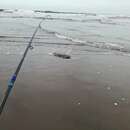en
names in breadcrumbs


The Chilean angelshark (Squatina armata) is an angelshark of the family Squatinidae found in the subtropical waters of Chile, that grows up to 1.03 metres (3 ft 5 in) in length. The holotype is lost. Reproduction is ovoviviparous.
The Chilean Armata mainly consumes lizardfish, teleosts and their remains, crustaceans, mollusks, elasmobranchs, and some species of shrimp. The species can be labeled as a selective, piscivorous, and carcinophagus predator. [3] They were also found to be specialist predators, meaning that they only feed on limited prey types and in specific environments.
 Head
Head The Chilean angelshark (Squatina armata) is an angelshark of the family Squatinidae found in the subtropical waters of Chile, that grows up to 1.03 metres (3 ft 5 in) in length. The holotype is lost. Reproduction is ovoviviparous.